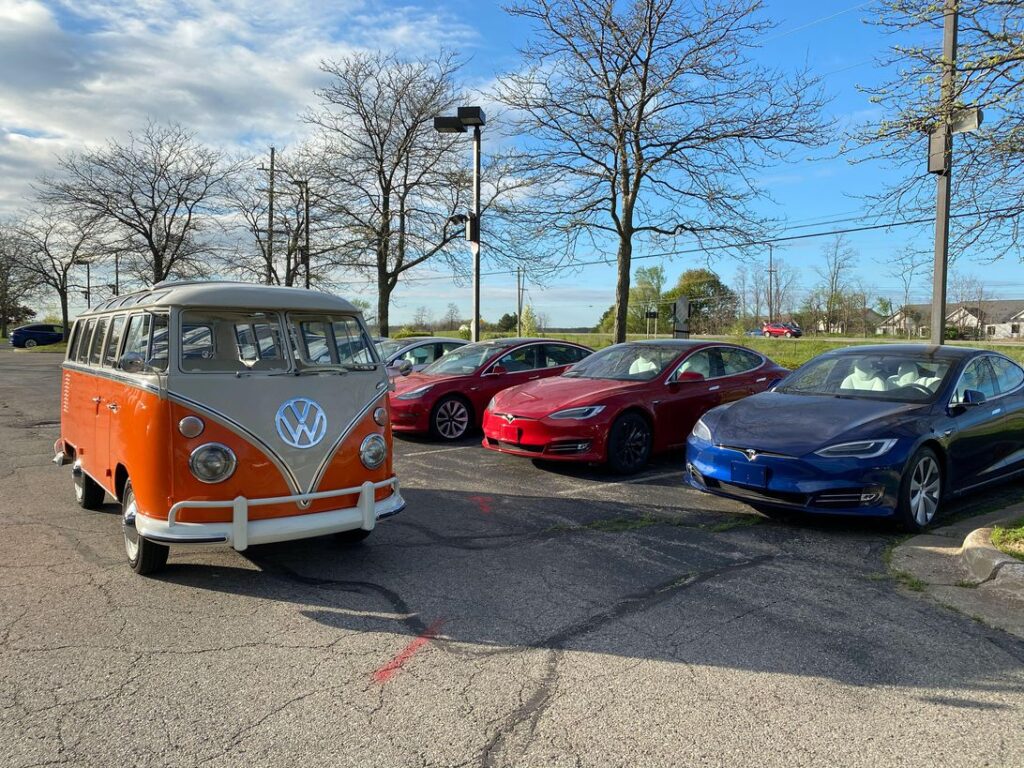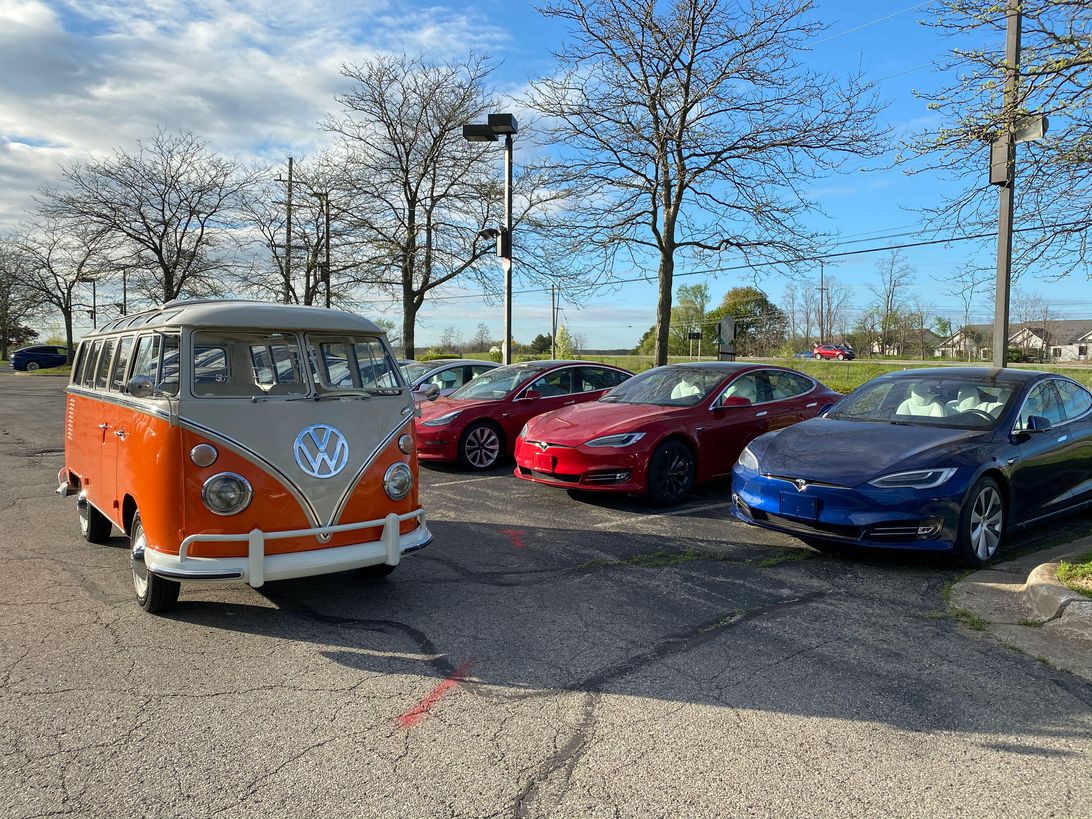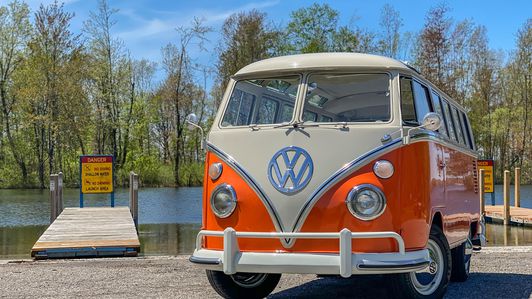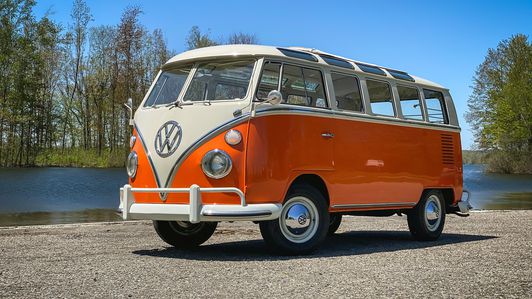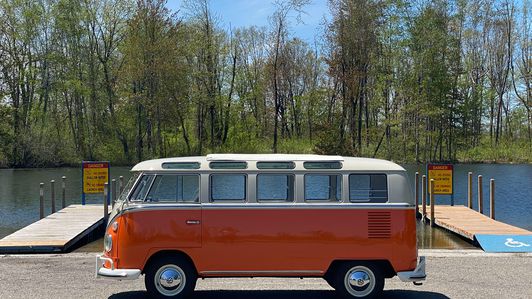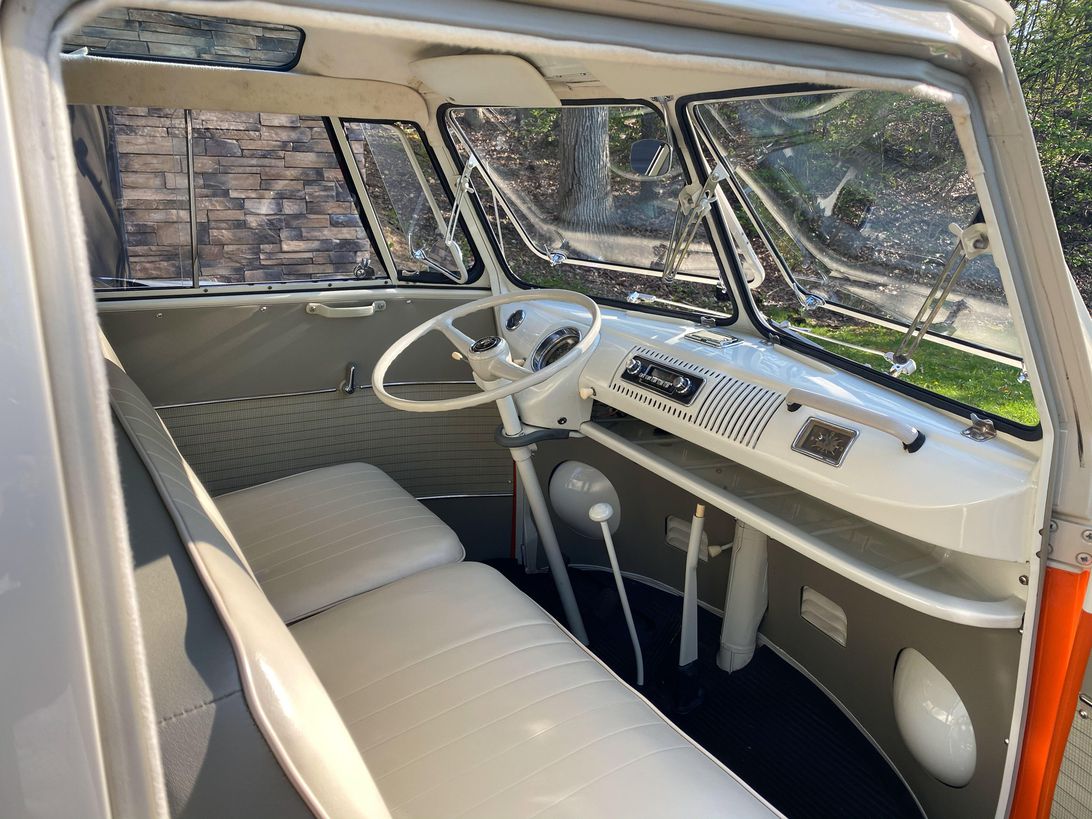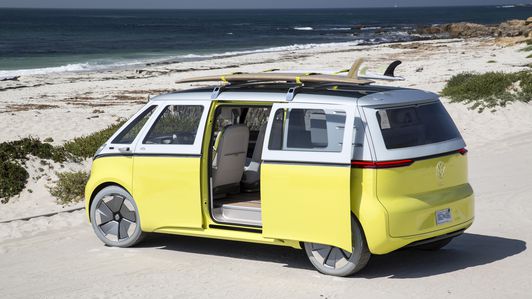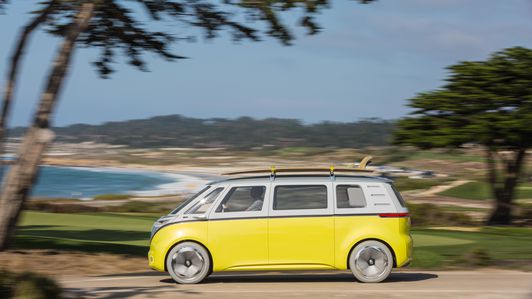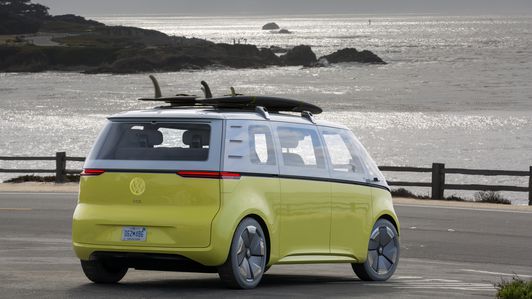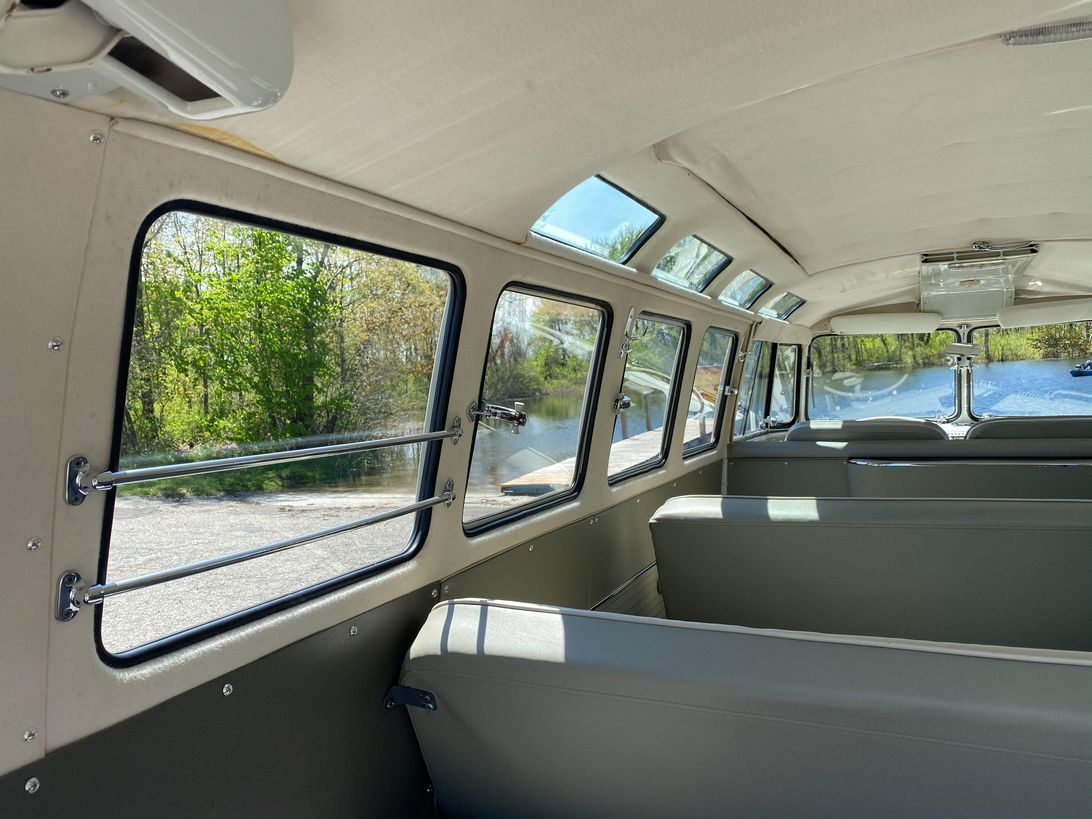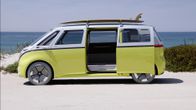VW’s electric challenger is coming for Elon’s lunch money sooner than you think.
Chris Paukert/Roadshow
If there’s a vehicle capable of generating more smiles and friendly waves by its very presence than a vintage Volkswagen Bus, I’m not sure what it is. It helps that the 21-window 1967 VW Type 2 Microbus Custom Deluxe I’m piloting is two-tone creamsicle orange, an undeniably sunny look that simply can’t be ignored. But there’s more to it than that. From its rounded bread-box shape to its cartoonish, wide-eyed stare, the VW bus isn’t just whimsy on wheels; its historical image is gilded with Bohemian iconography and positive vibrations — flower power, free love and peace. I’m not exactly a hippie, but I’m an absolute sucker for minimalist design, and I’ve always admired the simultaneously purposeful and playful personality of VW’s Bus.
It’s exactly this sort of ageless, class-free enthusiasm that has motivated the German automaker to serially revisit the idea of offering a new Bus. The company has periodically dangled new concept vehicles like the 2001 Microbus, 2011 Bulli and 2016 Budd-E to the hungry masses, only for subsequent production rumors to amount to nothing. But that’s finally changed. In the wake of the Dieselgate scandal, Volkswagen has officially confirmed it will produce an all-electric Bus based on the show-stopping ID Buzz concept vehicle from 2017, built atop the company’s new Modular Electric Drive Matrix platform. Not only that, VW has partnered with an aftermarket electric-car-conversion firm, eClassics, to produce a series of reengineered classic VW vans that run on batteries.
In other words, it’s as good a time as any to revisit Wolfsburg’s vintage Kombi van to see what it might be able to tell us about Volkswagen’s battery-powered future.
That old feeling
Even though I’ve driven plenty of old VWs, this is my first time driving a classic Microbus, and despite being a handful to operate, it’s an unmitigated joy. The thin-rimmed steering wheel is vast and mounted horizontally like a commercial bus, providing enhanced mechanical advantage to offset the unassisted steering. With a predictable-but-significant amount of play in this 1967’s linkage, you suddenly understand why drivers in all those old movies constantly shuffle their wheels back and forth. Even on interstates, this Transporter forces its driver to adopt something between a twist and a shimmy at the wheel just to keep things on the straight and narrow.
Thanks to the VW’s slim (albeit myriad) pillars and low-back seats, outward visibility is commanding stuff in all directions. in particular, it helps that there’s no hood to get in the way of… well, anything. Having grown up in automobiles with crumple zones, padded dashboards, three-point seatbelts and windshield wipers that work without unclipping (really), it takes a bit of time to not feel defenseless and acclimate to this retro life. After all, you immediately sense that your legs have suddenly become an integral part of the VW’s crash structure and the front end is so thin that bowl-shaped cutouts for the headlamp innards protrude into the footwells.
Vulnerabilities aside, the minimalist charms of this vintage VeeDub are ineffable. Frankly, you don’t realize how much you miss the cold, authentic touch and the shiny finish of real metal in car cabins until you’re presented with an old-school ride like this VW. The gorgeous brightwork trimming the windows — especially the delicate sliders that tilt open the split windshield — invite you to fiddle. The incredibly long gearstick capped with what appears to be a simple bakelite knob is fun and surprisingly easy to operate thanks to friendly clutch engagement (though reverse gear — down and to the left — occasionally goes missing, especially during cold starts). The roof-mounted air inlet switch on this Samba is surprisingly effective at speed, however, the pushbutton AM radio isn’t, so I tote along a small Bose Bluetooth speaker for an era-appropriate, Allman-Brothers-heavy backing soundtrack during my drive days.
The Bus’ dash and gauges are minimalism defined. Note the split, tilt-out safari-style windshield.
Chris Paukert/Roadshow
Air-cooled drive
Once the raucous, air-cooled engine warms through, it doesn’t take long before I’m belting all 1.5 liters of the tiny rear-mounted flat four, looking to extract every one of its 53 horsepower so as not to impede traffic beyond the bounds of the VW’s goodwill. It takes a lot of patience and runway, but the rear-wheel-drive Microbus will almost manage modern highway speeds, though it takes dead-flat tarmac or a favorable downhill slope to avoid becoming a moving chicane on Michigan’s fast-moving freeways. Others might feel vulnerable in a vehicle with so little accelerative authority, but I’ve had a lot of experience with underpowered, round-eyed throwbacks (my Nissan Pao Japanese import only came with 51 hp). As a result, the VW’s lack of oomph and its stated top speed of 65 mph doesn’t curb my enthusiasm, though it’s clearly best to stick with country roads.
Thanks to short overhangs, thin panels and a space-efficient powertrain configuration, this 1967 Bus is a packaging marvel. This particular example’s bench seats accommodate no fewer than nine passengers. Nine. This, in a footprint that’s just 168.5 inches long — well over a foot shorter than a modern Honda Civic sedan. The latter also weighs a lot more — 2,762 pounds for a base LX versus just over 2,300 pounds for the VeeDub. No doubt with all those batteries to haul around, the production version of the 2022 ID Buzz will be far heavier still, especially since it’s likely to be substantially larger.
It’s always interesting to report when a vintage vehicle drives “more modern” than you might reasonably expect — any number of classic Mercedes-Benz models including the fabled 300 SL Gullwing accomplish this feat startlingly well. I’m not going to lie and tell you that’s the case here. Even with more power to more easily keep up with traffic, you wouldn’t want to daily drive one of these based purely on their yestertech hydraulic drum brakes and crosswind-sensitivities alone. But that’s not what classic air-cooled VW ownership is about, whether you’re talking Bus, Beetle, Thing or Karmann Ghia. And that’s just fine by me, because piloting this one-box gem is an experience whose many joys unfurl at their own, leisurely pace — a one-car parade on demand.
Just because you’re a single-car spectacle doesn’t mean driving is a leisurely task. Not since I briefly drove a Land Rover Series I has so much activity and mindfulness resulted in so little speed and progress. With minimal power and such great wind resistance (even without the Samba fabric roof open), you, the driver, are always up to something. Just oozing up to the speed of slower traffic, your feet are called to dance between the petite pedals and swizzle the gearshift far more frequently than in any modern automobile. The steering wheel is constantly shuffled to counterbalance dead spots and gusts of wind. Mirrors must be habitually checked for fast-approaching motorists. It’d be exhausting if it weren’t so ceaselessly enjoyable.
This VW seats nine people in an airy bodyshell that’s over a foot shorter than a modern Honda Civic.
Chris Paukert/Roadshow
Classic VW Bus values and ID Buzz pricing
Nostalgia often carries a jarringly high price tag. Vintage first-gen 1950-1967 split-window VW Bus models are no different, and the prices go up sharply the more panes of glass you find in their greenhouses. A good, 21-window Bus can command $130,000 to $150,000 today. Despite being part of VW’s private collection, my driver isn’t perfect, but a VW official I spoke with ballparked its value similarly. That feels reasonable given its desirable color combination and the fact that concours-condition examples can fetch tens of thousands more. The best 23-window models have cracked over $200,000 at auction.
Prices seem to have plateaued somewhat of late, but it’s worth remembering that these very same breadboxes used to be $25K to $50K not long ago. Sadly, monied Baby Boomers have driven prices out of sight, and Gen Xers including comedian Gabriel “Fluffy” Iglesias are picking up right where they left off.
Fortunately, when the 2022 Volkswagen ID Buzz rolls into showrooms — hopefully with a more evocative name — VW will almost certainly ask for a lot less money. Details about the new generation remain slim, but it seems likely that the automaker will put the model’s starting price at $45,000 or so. Given a paucity of new van models — let alone electric ones — it seems reasonable to assume that the neo Bus will have to carve out its own market niche. However, if VW gets the tech right, I could even see the Bus winning over some Tesla Model Y and Nissan Ariya intenders, as they would be priced similarly. Frankly, if Volkswagen is able to instill even a tenth of the charm of this 1967 Bus in its new EV, it should be an absolute blockbuster.
A 1.5-liter air-cooled flat-four hides in a cubby just above that rear bumper.
Chris Paukert/Roadshow
What VW must get right with the EV
Most people who buy VW’s forthcoming electric Bus will never have sat shotgun in a vintage example like this one, let alone slipped behind its massive wheel. But in order for the model’s revival to feel authentic, I humbly submit that it’d be wise for VW designers to hold on to certain virtues of the original. Chief among them? Honest, purposeful design. Prioritize space efficiency and good visibility. Avoid whimsical design touches for the sake thereof — it’s possible to design things that are both purposeful and have a sense of humor.
For a company betting billions on its ability to become a global EV powerhouse while simultaneously emerging from the shadows of major corporate scandal, VW could certainly stand to see a few more smiling faces among the world’s consumers. I can think of no better way to make that a reality than to introduce a clean, green new VW Bus for the future.
Make mine creamsicle orange.
